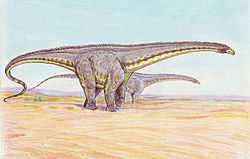Diplodocoidea
| Diplodocoids Temporal range: Late Jurassic–Early Cretaceous, 154–93Ma | |
|---|---|
 | |
| Diplodocus | |
| Scientific classification | |
| Kingdom: | Animalia |
| Phylum: | Chordata |
| Clade: | Dinosauria |
| Suborder: | †Sauropodomorpha |
| Clade: | †Neosauropoda |
| Superfamily: | †Diplodocoidea Marsh, 1884 |
| Type species | |
| Diplodocus longus Marsh, 1878 | |
| Synonyms | |
| |
Diplodocoidea was a superfamily of sauropod dinosaurs, which included some of the longest animals of all time, including slender giants like Supersaurus, Diplodocus, Apatosaurus, and Amphicoelias. Most had very long necks and long, whip-like tails; however, one family (the dicraeosaurids) are the only known sauropods to have re-evolved a short neck, presumably an adaptation for feeding low to the ground. This adaptation was taken to the extreme in the highly specialized sauropod Brachytrachelopan. A study of snout shape and dental microwear in diplodocoids showed that the square snouts, large proportion of pits, and fine subparallel scratches in Apatosaurus, Diplodocus, Nigersaurus, and Rebbachisaurus suggest ground-height nonselective browsing; the narrow snouts of Dicraeosaurus, Suuwassea, and Tornieria and the coarse scratches and gouges on the teeth of Dicraeosaurus suggest mid-height selective browsing in those taxa.[1] This taxon is also noteworthy because diplodocoid sauropods had the highest tooth replacement rates of any vertebrates, as exemplified by Nigersaurus, which had new teeth erupting every 30 days.[2]
Taxonomy
Infraorder Sauropoda
- Superfamily Diplodocoidea
- Amazonsaurus
- Amphicoelias
- Cetiosauriscus[3]
- Family Rebbachisauridae
- Flagellicaudata (whip-tails)
- Family Dicraeosauridae
- Family Diplodocidae

The following cladogram follows an analysis by Sereno et al. in 2007.[2]
| Diplodocoidea |
| |||||||||||||||||||||||||||||||||||||||||||||||||||||||||||||||||||||
| |
References
- ↑ http://www.ploscollections.org/article/info%3Adoi%2F10.1371%2Fjournal.pone.0018304;jsessionid=B5ED8399160D7F46A7647ADE513F5B9C.ambra01
- ↑ 2.0 2.1 Sereno PC, Wilson JA, Witmer LM, Whitlock JA, Maga A, et al. (2007) Structural Extremes in a Cretaceous Dinosaur. PLoS ONE 2(11): e1230.
- ↑ Weishampel, D.B.; Dodson, P.; Osmolska, H. (2004). "The Dinosauria: Second Edition". Berkeley: University of California Press, p. 99. ISBN 0-520-24209-2.